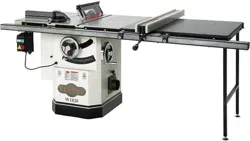Loading ...
Loading ...
Loading ...

-14-
Model W1819/W1820 (Mfg. Since 09/11)
SAFETY
The following is a list of common definitions, terms and phrases used throughout this manual as they relate
to this table saw and woodworking in general. Become familiar with these terms for assembling, adjusting
or operating this machine.
Glossary.of.Terms
Arbor: Rotating metal shaft to which saw blade
is mounted that extends from the drive
mechanism.
Bevel Edge Cut: Tilting the arbor and saw
blade to an angle between 0° and 45° to
cut a beveled edge onto a workpiece.
Blade Guard: Metal or plastic safety device
that mounts over the saw blade. Its
function is to prevent the operator from
coming into contact with the saw blade.
Crosscut: Cutting operation in which the fence
is used to cut across the grain, or the miter
gauge is used to cut across the shortest
width of the workpiece.
Dado Blade: Blade or set of blades that are
used to cut wide grooves and rabbets.
Dado Cut: "Non-through" cutting operation that
uses a dado blade to cut a flat-bottomed
groove into the face of the workpiece.
Featherboard: Safety device used to keep the
workpiece against the rip fence and table
surface.
Kerf: The resulting cut or gap in the workpiece
after the saw blade passes through during
a cutting operation.
Kickback: An event in which the workpiece is
propelled back towards the operator at a
high rate of speed.
Parallel: Being an equal distance apart at every
point along two given lines or planes. I.e.
the rip fence face is parallel to the face of
the saw blade.
Non-Through.Cut: A cut in which the blade
does not cut through the top of the
workpiece. Refer to Page.32 for more
details.
Perpendicular: Lines or planes that intersect
and form right angles. I.e. the blade is
perpendicular to the table surface.
Push.Stick: Safety device used to push the
workpiece through a cutting operation.
Used most often when rip cutting thin
workpieces.
Rabbet: Cutting operation that creates an
L-shaped channel along the edge of the
workpiece.
Riving.Knife: Metal plate located behind the
blade. It maintains the kerf opening in the
wood when performing a cutting operation.
Refer to Page.38 for more details.
Straightedge: A tool used to check the flatness,
parallelism, or consistency of a surface(s).
Through.Cut: A sawing operation in which the
workpiece is completely sawn through.
Rip.Cut: Cutting operation in which the rip
fence is used to cut with the grain, or
across the widest width of the workpiece.
Loading ...
Loading ...
Loading ...
